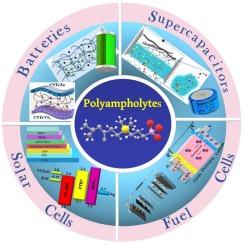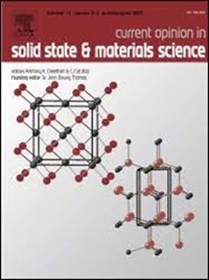多两性聚合物在能量储存中的研究进展
IF 13.4
2区 材料科学
Q1 MATERIALS SCIENCE, MULTIDISCIPLINARY
Current Opinion in Solid State & Materials Science
Pub Date : 2025-08-27
DOI:10.1016/j.cossms.2025.101239
引用次数: 0
摘要
多两性电解质的结构中含有正电荷和负电荷基团,表现出优异的电化学性能,使其适合于储能应用。它们与离子和自缔合形成强库仑相互作用的独特能力,特别是在水环境中,提高了电极和电解质的性能。多两性离子是多两性离子的一个亚群,其广泛的研究已经证明了它们在各种系统中的应用,如电池、超级电容器、燃料电池和太阳能电池。多两性聚合物提高了电池的稳定性、安全性和整体性能,从而增加了功率输出。它们已被用作电池中的凝胶电解质,以解决离子剥离/电镀造成的有限循环寿命。在超级电容器中,聚两性聚合物水凝胶以其作为电解质、粘合剂和分离器的多功能特性增强了离子电导率,减少了浓度极化。在燃料电池中,聚两性聚合物膜有效地阻断活性成分,同时保持高离子导电性。两性离子通过改善电荷传输和增强内部电场,在有机发光二极管(oled)、钙钛矿太阳能电池(PVSCs)和有机太阳能电池(OSCs)等光电子器件的表面涂层中显示出前景。本文对近年来多两性电解质的研究进行了分析,分析了其局限性和未来前景,并为储能应用提供了新的思路。本文章由计算机程序翻译,如有差异,请以英文原文为准。

Polyampholytes in energy storage: A review
Polyampholytes contain both positively and negatively charged groups in their structure, which exhibit remarkable electrochemical properties that make them suitable for energy storage applications. Their unique ability to form strong Coulombic interactions with ions and self-associate, especially in aqueous environments, enhances the performance of electrodes and electrolytes. Extensive research on polyzwitterions, a subgroup of polyampholytes, has demonstrated their application in various systems such as batteries, supercapacitors, fuel cells and solar cells. Polyampholytes improve stability, safety, and overall performance in batteries, leading to increased power output. They have been utilized as gel electrolytes in batteries to address the limited cycle life caused by ion stripping/plating. In supercapacitors, polyampholyte hydrogels enhance ionic conductivity and reduce concentration polarization with their multifunctional properties as electrolytes, binders, and separators. In fuel cells, polyampholyte membranes effectively block active components while maintaining high ionic conductivity. Zwitterions show promise as surface coatings in optoelectronic devices like organic light-emitting diodes (OLEDs), perovskite solar cells (PVSCs), and organic solar cells (OSCs) by improving charge transport and enhancing internal electric fields. This review analyzes recent studies on polyampholytes, examining their limitations and future prospects, and inspires new ideas for energy storage applications.
求助全文
通过发布文献求助,成功后即可免费获取论文全文。
去求助
来源期刊

Current Opinion in Solid State & Materials Science
工程技术-材料科学:综合
CiteScore
21.10
自引率
3.60%
发文量
41
审稿时长
47 days
期刊介绍:
Title: Current Opinion in Solid State & Materials Science
Journal Overview:
Aims to provide a snapshot of the latest research and advances in materials science
Publishes six issues per year, each containing reviews covering exciting and developing areas of materials science
Each issue comprises 2-3 sections of reviews commissioned by international researchers who are experts in their fields
Provides materials scientists with the opportunity to stay informed about current developments in their own and related areas of research
Promotes cross-fertilization of ideas across an increasingly interdisciplinary field
 求助内容:
求助内容: 应助结果提醒方式:
应助结果提醒方式:


